I may receive a commission if you purchase through links in this post. I am not a doctor; please consult your practitioner before changing your supplement or healthcare regimen.
This Homemade Lite Salt/Salt Substitute Recipe uses salt + potassium chloride to create a delicious condiment that’s healthier for many people than salt. It solves four problems, or it provides four solutions:
- Some patients need decreased sodium intake.
- Others of us need more potassium in our diets, so they’re more balanced and mineral rich, or to address more serious health concerns.
- Many of us are looking for uncontaminated salt. This recipe allows us to control the purity of the ingredients we eat.
- If you buy pre-made salt-potassium low sodium products (like Morton’s), they contain anti-caking agents and potassium iodide.
Homemade Lite Salt/Salt Substitute is the answer! This great-tasting condiment is used for cooking, seasoning and all your culinary needs. Better for you + SO fast and easy to make.
And, unlike store bought low salt products, you get to control the amount of sodium and potassium in your Homemade Salt Substitute. (Yes, while the main recipe uses a 60:40 ratio, you can adjust this according to your tastes or mineral/medical needs.)
Let’s start with the ingredients you’ll need.
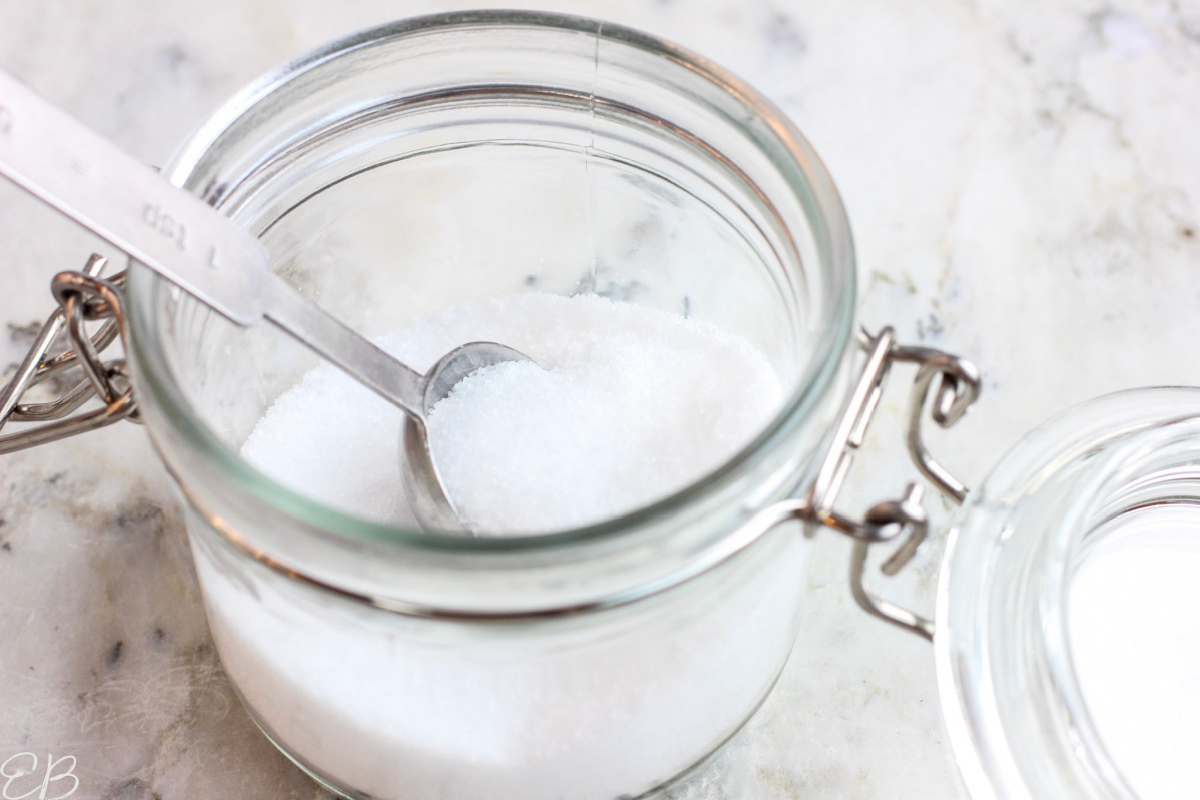
Ingredients to make basic Lite Salt/Salt Substitute Recipe
Only two ingredients are used to make Lite Salt/Salt Substitute:
- refined white sea salt — No, it’s not mineral rich. But that’s okay, because we’re adding the most important mineral, potassium, to it. Instead, it’s safely refined, and in this process, impurities (and minerals we don’t want) are removed. More on this just below!
- potassium chloride — The form of potassium our bodies need is potassium chloride. Choose this brand for the best flavor.
One other ingredient may also be used for flavor, and that’s cream of tartar (or potassium bound to tartaric acid), which is optional. I leave it out, personally. But some people find they like the flavor of their Lite Salt better when it is added. (Potassium chloride can taste metallic or bitter, whereas cream of tartar tastes tangy and offsets that.)
Cream of Tartar is completely natural, a byproduct of fermenting grapes, and actually another form of potassium, potassium bitartrate.
One reason to make Lite Salt/Salt Substitute: Purity
YES, so many of us want to eat clean foods! We try our best to live low stress and make great choices about sourcing and the water we drink.
But then we find out some source of food we’ve been eating is contaminated!
This is true, as you may know, with salt, too!
Microplastics
Microplastics are one main concern. In regard to the health and toxicity dangers, one study states, “… microplastics may accumulate and exert localized particle toxicity by inducing or enhancing an immune response”.
The solution is not mined or pink salt. Here’s why. And table salts contain a higher percentage of microplastics than other salts.
Minerals we don’t want
Unrefined sea salt, pink salts and Redmond Real Salt also contain a wide array of minerals, not all of them healthy or safe for the body.
Examples include copper, iodine and manganese. While we’ve been told these colorful salts are healthy, in fact, most people are copper toxic, especially women or those who crave chocolate. So a salt that adds a greater burden of copper to our bodies is harmful.
The helpful minerals in colorful salts, like zinc, are not in plentiful enough supply to make a difference to our wellness. Personally, I supplement with zinc.
Where did Lite Salt or Salt Substitute originate
In the last several decades, doctors have linked sodium intake with high blood pressure. Studies have repeatedly shown an increased risk of cardiovascular disease with elevated dietary sodium intakes, usually resulting from a processed foods diet.
Both medical doctors and the FDA understand that adding potassium chloride to the diet, in place of some sodium, improves blood pressure regulation. (source)
Reduced risk of stroke
Several other studies have found an inverse association between potassium intake and risk of stroke. (source)
Salt companies, like Morton’s, responded to doctors’ dietary protocol for their patients by coming up with a reduced sodium product, made up of half (or almost half) potassium.
Is sodium bad for us
In fact, if someone is eating a homemade whole foods diet, sodium is a nutrient our bodies need. In this setting, if we use non-iodized salt “to taste”, it is not a dangerous seasoning.
The problem with sodium occurs when people eat a diet of processed foods, which are very high in sodium. In this situation, the vegetable oils and other chemicals are just as dangerous as the sodium. Of course, doctors’ first orders should be to eliminate all processed foods and to start eating organic meats with a balanced diet of other whole foods.
The American Heart Association recommends between 1500 and 2300 milligrams of sodium per day for most adults. When we stay away from processed foods, this range is not a difficult goal to meet.
In reality, according to the 2020-2025 Dietary Guidelines for Americans, 97% of males exceed that goal, consuming 4172 mg of sodium daily, and 82% of females consume 3062 mg daily! (source, source)
Meanwhile, for people who are potassium deficient. Making one’s own Salt-Potassium Recipe is the perfect solution: Reduce processed foods, reduce sodium, and increase potassium!

Who is potassium deficient
Symptoms of low potassium include: trouble falling asleep, fast or irregular heartbeat when trying to fall asleep, foot or leg cramps, depression, anxiety and low energy levels.
Potassium deficiency is often the case for patients with thyroid problems, hypertension or diabetes, and it can be a factor in many health crises.
The best way to find out if your potassium deficient is to have a doctor tell you you’re deficient from testing. But symptoms and lifestyle choices can be good indicators.
Contributing factors to low potassium
If you take Vitamin D or eat foods high in Vitamin A, low potassium levels are more likely.
Vitamin D supplements cause the loss of potassium through the kidneys (source), which is one of the reasons I use a Vitamin D lamp (here) instead of oral supplements.
Vitamin A from foods also blocks potassium channels. (source) Thus, two causal factors in food and supplements that deplete the body of potassium.
Other contributing factors include: low carb diets, high/all meat or carnivore diets — These diets are high in sodium but do not contain potassium. This recipe could be a good solution, without the carbs. (source)
Hair mineral analysis testing
Hair mineral analysis is a method that’s gained new respect and usefulness even among mainstream researchers.
As multiple studies show us, “Measurements of trace elements in hair have been successful because hair can provide a more accurate record over time than blood or urine of trace elements … The analysis of mineral concentrations in hair is not medically diagnostic, but provides a method of evaluating the entire body. Studies have assessed the relationships between the mineral analysis of hair and various disorders, including cancer, kidney disease, fibromyalgia, and osteoarthritis.” (source)
Based on hair mineral analyses of patients eating a whole foods diet, many but not all people are potassium deficient.
The recommended intake for potassium is 2600 mg/day for women and 3400 mg/day for men, in apparently healthy populations, or more, depending on the source (up to 4700 mg daily, for men). (source)
Food sources of potassium are a good way to address a potassium deficiency, for some. Food sources include:
- coconut water
- bananas
- legumes
- seeds
- nuts
- whole grains
- peeled potatoes
Eating these foods in higher volume for a designated period of time can be a good indicator of whether your body needs more potassium.
For anyone who can’t get enough potassium from food sources, Homemade Lite Salt/Salt Substitute is a great solution.
Is extra potassium ever dangerous?
Safety concerns with consuming potassium rarely exist in healthy people because healthy kidneys adjust potassium levels.
If someone has chronic kidney disease, heart disease, high blood pressure, liver disease or diabetes, or uses ACE inhibitors or potassium-sparing diuretics, they should consult with their doctor before consuming extra potassium. (source, source)
Too much potassium could lead to the following symptoms: vomiting, nausea, upset stomach, gas, diarrhea, heart arrhythmias and tingling in the hands or feet. You might be taking in too much potassium also if you notice these symptoms: trouble falling asleep, anxiety, depression or fatigue.
Sodium and potassium balance each other in our bodies. It would be dangerous to take really high doses of potassium without taking in a comparable amount of sodium. Hopefully most people know not to do such things.
And, this recipe is protective, because sodium and potassium balance each other.
Note: Avoid potassium iodide which is dangerous to the thyroid.
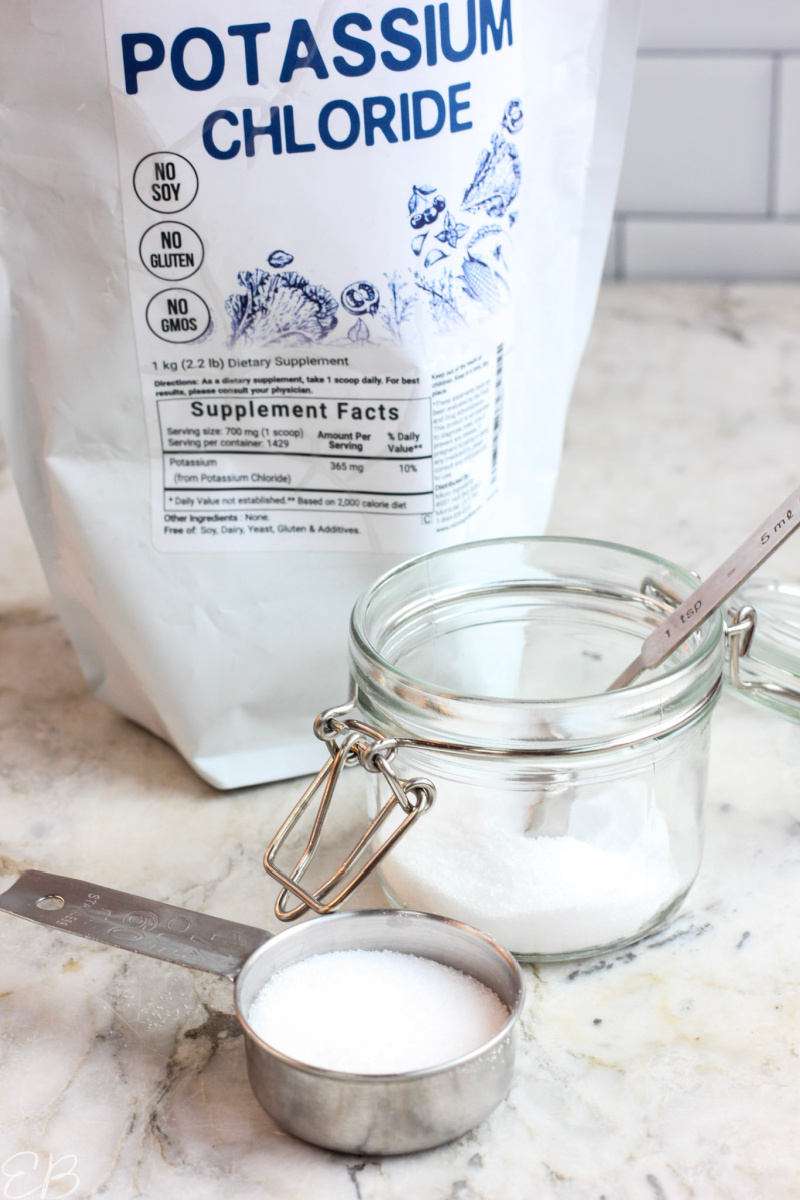
Salt isn’t just for taste: we need sodium
In case you’re wondering about the value of salt, it’s good that we salt our food!
Sodium is needed by our bodies to maintain proper plasma volume in extracellular fluid, which affects cardiovascular health. (source)
Recommendations for daily salt intake are 2500 to 3000 mg.
Sodium and chloride ions also play important roles in the nervous and digestive systems.
How does Homemade Lite Salt/Salt Substitute taste
The best judge is my own family.
When I switched to making this low sodium-high potassium salt, no one noticed! They still don’t know. For cooking and light seasoning, you can not tell the difference.
However, with that said — I can definitely tell the difference if I taste it by itself or put a lot on a bite of food. No, it is not as delicious as regular high quality sea salt.
For this reason, I do recommend you choose this Potassium Chloride product, as it’s the best tasting one and will give you the best success with your end result.
Finding the right recipe for your taste preference
The ratio of salt and potassium may be adjusted in this recipe, according to taste.
And cream of tartar, as mentioned in the introduction, may be added for those who find it helpful flavor-wise. (Cream of tartar is another form of potassium.)
If the ratio of 60% salt to 40% potassium, outlined below in the main recipe, (by weight) has too strong of a potassium flavor for you, you can do one of two things:
- Change the ratio to more salt and less potassium, for example 70% salt and 30% potassium.
- Or create a salt blend like this: 1/3 salt, 1/3 potassium chloride (by volume) and 1/3 spices like onion powder and garlic powder, dried ground lemon zest, ground celery seed and/or pepper.
Consider a finishing salt
My personal solution for the flavor of Lite Salt not being as good is to: use a delicious finishing salt! (Do not do this if you are on a low salt diet from your doctor for medical reasons.)
This means:
- Cook with Homemade Lite Salt (recipe below).
- After you’re done cooking, have a dish of high quality, lovely-flavored Celtic Sea Salt on the table for salting to taste. I sprinkle this on top of my food for the best flavor.
Celtic Sea Salt tested lowest in microplastics, at almost undetectable levels. I also take nano-particle zeolite spray daily, so I know my body is detoxing any tiny amounts I take in from many various sources.
Find finely ground Celtic Sea Salt here, or bulk coarsely ground here.
Maldon’s white flake salt is another lovely finishing salt that I also use. (I buy this one in bulk.)
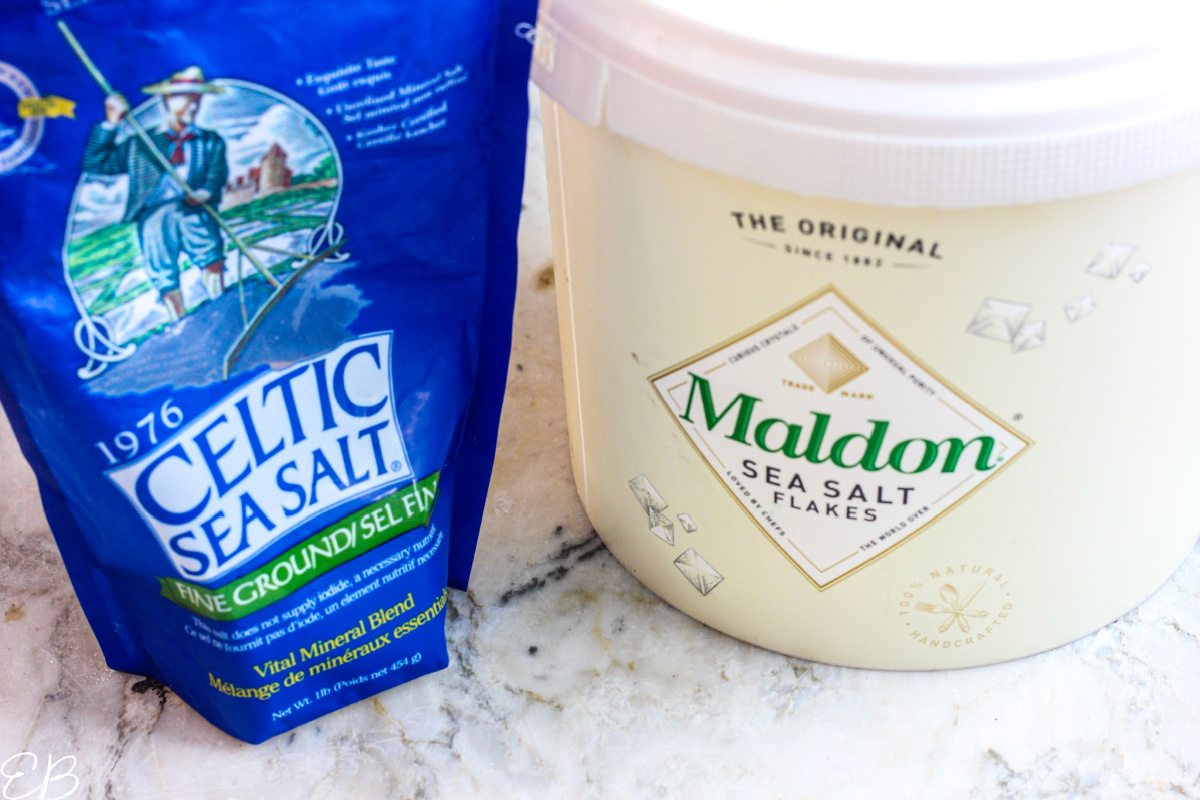
What about if you need less sodium and want more potassium
The ratio of salt to potassium can easily be changed.
If you need lower sodium and/or higher potassium, change the recipe to a ratio of 50% salt, 50% potassium! It is very easy to measure and create this recipe 50:50.
Potential benefits from increased potassium
- reduced risk of bone loss and osteoporosis (source, source)
- help preventing kidney stones (source, source 1 below)
- reduction of blood pressure and improved hypertension (sources 1, 2, 3)
- muscle and nervous system benefits
- improvement in any or all of the symptoms listed under potassium deficiency
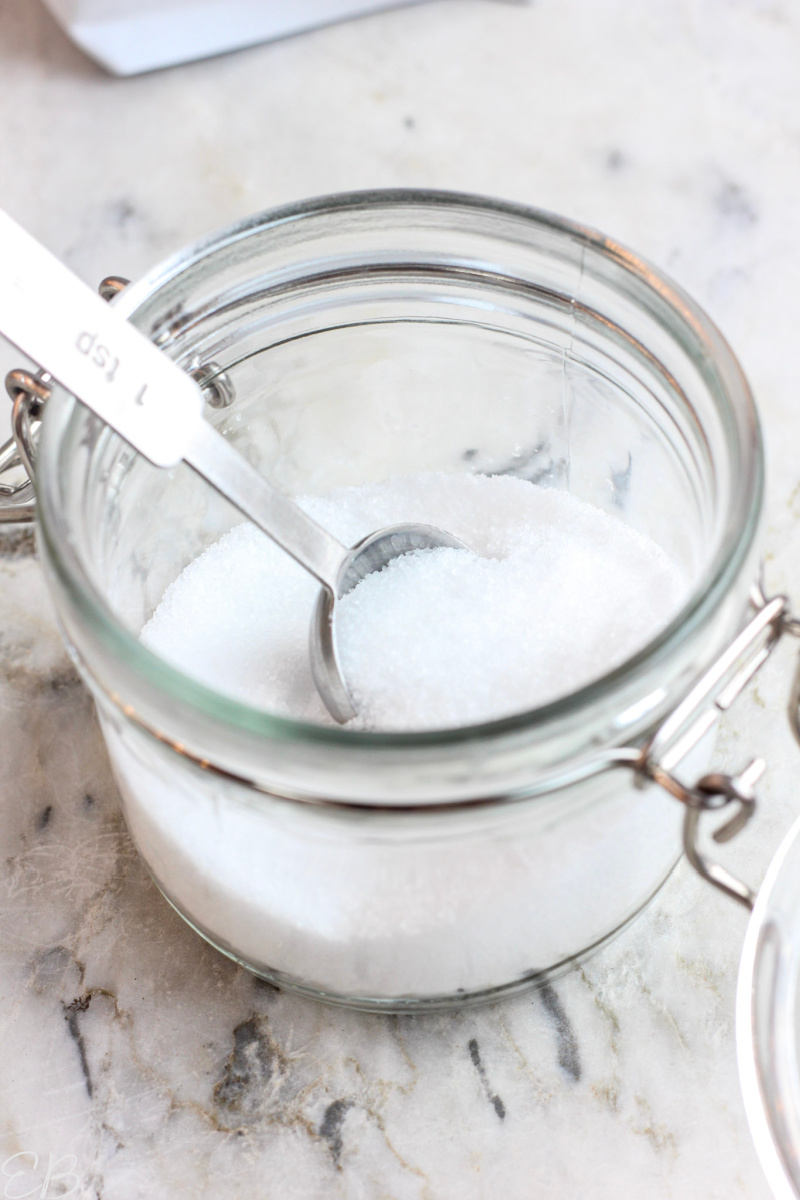
Homemade Lite Salt/Salt Substitute ~ salt + potassium recipe
Equipment
- optional scale, for weighing food OR optional measuring cups/spoons (But none of these are needed. See the Notes section for alternative.)
Ingredients
Note: The quickest way to make this recipe is just to measure equal parts of salt and potassium chloride into a jar. This allows you to make any quantity that's convenient for you, plus it's so fast and easy. But, for those who would like the 60:40 recipe, that's also quite easy, plus nice to have in bulk, it's just below. Enjoy!
- 12 ounces sea salt white refined (or as few as 8 ounces if you want more potassium in your ratio/less sodium) -- If you don't have a food scale to weigh the ingredients, see the Notes section below.
- 8 ounces potassium chloride
- optional ¼ teaspoon cream of tartar (For some people, this improves the flavor of the overall recipe.)
Instructions
- In bowl or storage jar, combine all ingredients so they're well mixed.
- Seal and store in a mason jar for daily use.

Notes
If you don't have a food scale
A couple of options make this recipe easy to measure if you don't have a food scale, in order to weigh the ingredients:- Purchase one of your products (either the salt or potassium chloride) in an 8-ounce container. Use it as your measuring guide. After you dump the full contents into your mixing bowl or storage jar, use the same container to measure the second ingredient. (While the weights of each product are not exactly the same, they are close enough for the purposes of this recipe.)
- Measure by volume instead of by weight: use 1 cup of each product + the optional cream of tartar.
- Or, as noted just above the ingredients, for the 50:50 recipe, just measure by volume equal amounts of both main ingredients, in any quantity convenient for you.
Nutrition
You can Pin this recipe here:
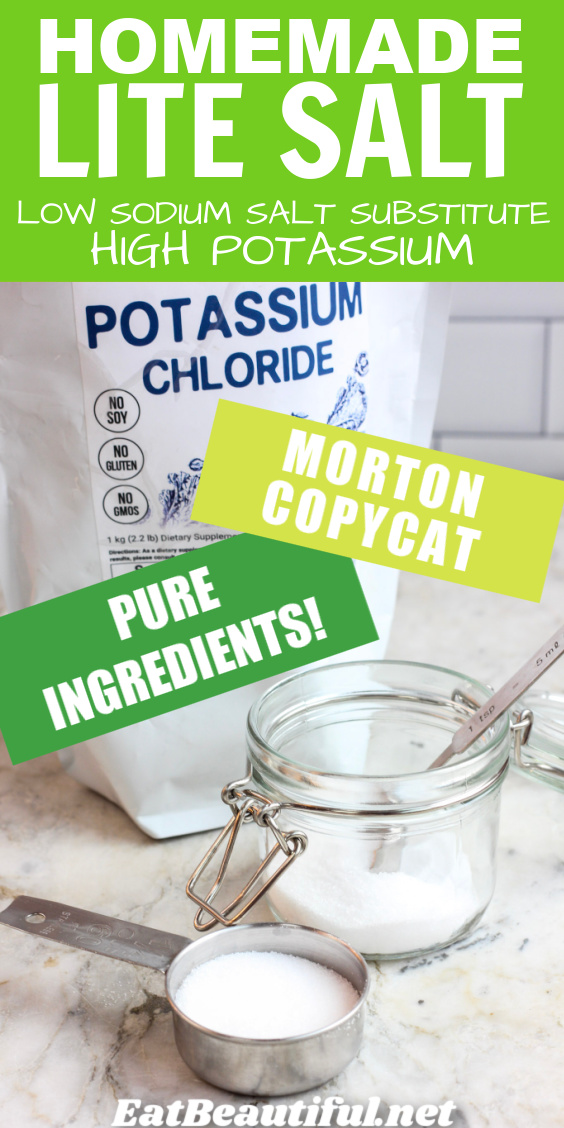
ADDITIONAL SOURCES
I first learned about “50/50 Salt” from Dr. Garrett Smith, who recommends it for many of his patients. Since then, I noticed it was discussed in other forums and have had EB readers ask me about it. This recipe concept is gaining ground from many different sources, for various reasons, for good reason.
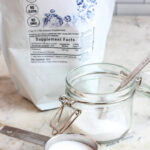


Amy says
Hi Megan,
what about iodine? I’ve heard that using sea salt does not provide the necessary levels of iodine and that makes most of us using sea salt deficient? Can you speak to this?
Megan says
Hi Amy, good questions. Too much iodine can cause hypothyroidism. While there is much debate on this, most agree, and I personally thought I was benefiting until after years of using it, I realized my chronic dizzy spells were from iodine. I personally believe we should do hair mineral analysis testing to see if we need a mineral (including iodine), but otherwise avoid trying to consume it. The idea of necessary levels of iodine is not accurate, because each individual has very different mineral needs. I hope that helps.
Heidi says
What’s the difference between potassium citrate and potassium chloride??
Can you use both? Which is better? Which has the best absorption? Does it matter?
Will both of them help with absorption?
Why do you prefer potassium chloryand not potassium citrate?
Thank you:)
Megan says
Hi Heidi, good question. Yes, only potassium chloride is recommended. All citrate forms of minerals are not recommended as they cause inflammation. Here’s one study: https://www.cambridge.org/core/journals/british-journal-of-nutrition/article/exogenous-citrate-impairs-glucose-tolerance-and-promotes-visceral-adipose-tissue-inflammation-in-mice/CC8224619E0381562123A1762E1AEFAD The other reason is: all mineral citrates are minerals bound to citric acid. Citric acid is created from GM black mold and messes up our copper metabolism.
Heidi says
Got it:).
Also why you don’t like boron? I thought boron is good in helping bones be stronger along with calcium? Boron also helps with removing heavy metals…
What’s the con on boron?
Thank you
Megan says
Dr. Smith describes something called the “Duration Paradox” wherein we can have short term benefits but long term problems from a supplement, which many of us have experienced. An example with boron is it having short term benefits on testosterone levels (10 days) but causing long term damage to fertility: https://www.ncbi.nlm.nih.gov/pmc/articles/PMC1566637/pdf/envhper00403-0110.pdf And here we see its toxicity to the kidneys and beyond: https://www.ncbi.nlm.nih.gov/pmc/articles/PMC2776007/ There are more studies, but this gives us plenty of reason to think again about boron. Good questions!
Flannery Diehl says
Blessings to you and your family with the arrival of your daughter.
I appreciate this information
Thank you
Megan says
Thank you, Flannery, so kind!, and I’m so glad! My pleasure. (By the way, what a beautiful name you have! I don’t hear it very often.)
Lea says
Interesting. In view of this discussion, what would be your perspective on electrolytes such as LMNT, Jigsaw or Redmond Re-lyte?
Megan says
Hi Lea, good question. I have looked at many many labels, and all of the products I’ve seen have unwanted ingredients or a not-ideal ratio of minerals, the wrong form of minerals, or all of the above. Because of that, I made my own! 🙂 DIY Electrolyte Powder recipe that’s quick to make and with the right ingredients in correct ratio for our body’s needs. It’s here and has more information on the topic as well: https://eatbeautiful.net/homemade-electrolyte-powder-easy-natural-diy-sports-drink/ In the case of this homemade recipe, I’m a fan! In the case of the store bought ones, no, because then we’re consuming undesirable minerals like copper, manganese, boron etc + citric acid, stevia, flavors, wrong forms of the minerals etc.
Roxanne says
Hi Megan, I love your interesting articles. My question is why would symptoms of too much potassium and too little potassium in your article be the same? I was a confused by that?
Megan says
Hi Roxanne, great question. This has to do with how electrolytes behave and how the body responds to imbalances. It’s not just potassium; the same is true of sodium. Many of the symptoms are different, but they can also be the same for deficiency and toxicity. The balance of electrolytes means that the body may mask a problem by compensating in another area, so what looks like one thing can be another. Electrolytes cause chemical reactions within our bodies and affect the balance of fluids inside and outside of cells, so we can see that in that balancing act, having too much or too little of a mineral could easily manifest in brain chemistry issues (confusion, for example) or heart rhythm changes either way, as the body tries to compensate for irregularities and the movement of fluids in and out of cells. Here’s an excellence reference article: https://my.clevelandclinic.org/health/diagnostics/21790-electrolytes
Virginia S. says
Hello,
What concerns you about Redmond Sea Salt? I really like their salt. I’ve just requested a mineral content list from them on their Real Salt.
I have tested (blood work) to have high copper and not enough zinc, so am trying to avoid high copper foods. I think I should try your Lite Salt recipe.
Megan says
Hi Virginia, Redmond Real Salt has a lot of trace minerals, so we are getting small amounts of copper when we eat it. For those of us who are copper toxic, this just doesn’t make sense. It makes more sense to eat salt with potassium added, since those are the two minerals we need. I hope that helps to clarify!
Vicki Lindquist says
Megan,
Thank you for making your Lite Salt/Salt Substitute recipe available. You had stated, “One other ingredient may also be used for flavor, and that’s cream of tartar (or potassium bound to tartaric acid), which is optional. I leave it out, personally. But some people find they like the flavor of their Lite Salt better when it is added.”
Is the cream of tartar in place of potassium chloride or is cream of tartar an added ingredient and if so how much would I add?
Megan says
Hi Vicki, happy to help! It is in the recipe actually, as an optional ingredient. 🙂 It is the 3rd Ingredient if you look again at the recipe.